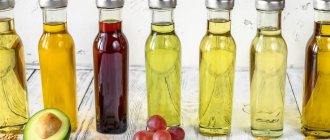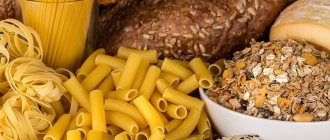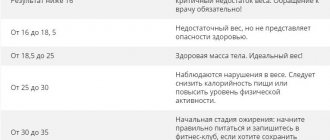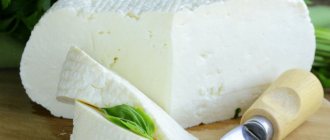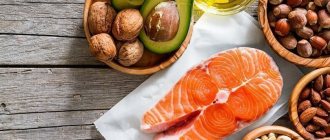What is energy value
The energy value of food (calorie content) is the energy that a person is able to absorb from them, that is, release in the process of biological oxidation of proteins , fats and carbohydrates .
However, nutrients are never completely absorbed by the human body. Carbohydrates are absorbed by 98%, fats by 95%, and proteins by 92%.
The nutritional energy value of food is measured in units such as calories or joules per 100 g of product.
To calculate the calorie content of food products, they are burned in a calorimeter and the amount of heat released is measured. One calorie is spent on heating 1 gram of water by 1 °C. For convenience, everyone uses kilocalories (kcal). One kilocalorie is spent on heating not 1 g, but 1 kg of water.
Method for calculating total energy value.
Determine the amount of food consumed, for example for breakfast.
Then, based on the information provided on the product packaging (energy value per 100 g), calculate the amount of energy consumed per serving. For example, 100g of ham is 84 kcal, so 20g of ham is 17 kcal.
Thus, to calculate the energy value of breakfast, you need to perform the following calculation:
- 1 bun (50 g) = 150 kcal
- butter (5 g) = 74 kcal
- ham or turkey (20 g) = 17 kcal
- cheese (20 g) = 79 kcal;
- 1 medium tomato (130 g) = 26 kcal,
- coffee (1 cup - 130 ml) + milk 2% fat (10 ml) + sugar (1 teaspoon - 5 g) = 3 + 5 kcal + 20 kcal.
The energy estimates of the individual food components are added up to give you the number of calories you consume by eating your breakfast: 150 kcal + 74 kcal + 17 kcal + 79 kcal + 26 kcal + 3 kcal + 5 kcal + 20 kcal = 374 kcal.
Energy balance of the body
The body's energy balance is a state in which the amount of energy entering the body is approximately equal to its expenditure, which allows one to maintain a stable weight.
There are types:
- Negative energy balance is a state where energy expenditure exceeds energy intake. It is observed during fasting and following all kinds of diets. The body begins to use all incoming nutrients, as well as fat and muscle, as energy.
- Positive energy balance is a state when the amount of energy entering the body exceeds its expenditure. This is the main reason for excess weight.
Calculation of nutritional and energy value
456
19.10.2020 16:56
One of the rights of the consumer is to receive reliable information about a food product, its composition and calorie content. That is why each manufacturer must accurately calculate the nutritional and energy value of the product and place the information obtained on the packaging of the finished product.
This requirement is established by technical regulation CU No. 022, which regulates food products in terms of their labeling. Calculation of protein, fat and carbohydrate content, as well as calorie content, is a non-alternative obligation for all food manufacturers.
How to calculate your daily calorie intake
The energy value of the diet is calculated individually. Energy expenditure varies from person to person. They depend on age, height, body weight, and physical activity. But despite this, it is possible to identify different groups of people with similar energy expenditures.
As an example, I will calculate the recommended calorie content:
- for women height 165 cm and weight 57 kg;
- for men height 178 cm and weight 70 kg.
Calculations will be for people of different ages and physical activity.
Light activity refers to the light loads of everyday life.
Average activity will be for people with three workouts per week.
| Age | Kcal |
| Women are inactive | |
| 20+ | 1800 |
| 30+ | 1700 |
| 40+ | 1700 |
| 50+ | 1600 |
| Women with average activity | |
| 20+ | 2000 |
| 30+ | 1900 |
| 40+ | 1800 |
| 50+ | 1700 |
| Men are inactive | |
| 20+ | 2400 |
| 30+ | 2300 |
| 40+ | 2200 |
| 50+ | 2000 |
| Men with average activity | |
| 20+ | 2600 |
| 30+ | 2500 |
| 40+ | 2400 |
| 50+ | 2200 |
Note! For those who do not coincide with the calculation group, they will have different recommended caloric intake standards. If you are taller or heavier, your energy needs will be slightly higher.
What is a calorie and calorie content?
A calorie represents the amount of energy it takes to heat one gram of water - from 19.5 to 20.5 ℃. The calorie content or energy value of food is the amount of energy that the body receives after completely digesting the food.
The daily calorie requirement is individual and depends on gender, age, level of physical activity and other factors
The energy value is usually indicated on the packaging. Its calculations are based on 100 g or 100 mg of product. Basically, information is provided in grams regarding the three main components - proteins, fats and carbohydrates (BJU). There are special units for calorie content: kilojoules (kJ) or kilocalories (kcal).
Fun fact: There are no zero or negative calorie foods. The exception is water, as it does not contain nutrients.
How is the calorie content of food products calculated?
The energy value of food products is calculated in two ways:
- laboratory – involves testing product samples in laboratory conditions;
- calculated - used to determine the calorie content of a finished dish, which includes several components. Based on the data specified in the BZHU protocol.
When calculating calorie content using the calculation method, the following content of kilocalories in nutrients is taken as a basis:
- 1 g of fat accounts for 9 kcal;
- for 1g of protein – 4 kcal;
- per 1 g of carbohydrates – 3.75 kcal.
These indicators are summed up, resulting in the calorie content of the product or finished dish.
How many calories should you eat per day?
Thus, the food consumed per day consists of 40% carbohydrates, 40% proteins, and 20% fats. The daily value of nutrient units depends on age, gender and level of physical activity.
For men
| 19-25 years old | 26-50 years | Over 51 years old |
| Passive lifestyle | ||
| 2400 kcal | 2000 kcal | 1800 kcal |
| Moderately active lifestyle | ||
| 2600-2800 kcal | 2500 kcal | 2300 kcal |
| Active lifestyle | ||
| 3000 kcal | 2800-3000 kcal | 2400-2800 kcal |
For women
| 19-25 years old | 26-50 years | Over 51 years old |
| Passive lifestyle | ||
| 2000 kcal | 1800 kcal | 1600 kcal |
| Moderately active lifestyle | ||
| 2200 kcal | 2200 kcal | 1800 kcal |
| Active lifestyle | ||
| 2400 kcal | 2200 kcal | 2000 kcal |
To keep yourself in shape, do not exceed the permissible limits.
When planning your menu, we must not forget that in addition to the nutritional value of food, you need to take into account its quality. Therefore, it should be balanced, moderately saturated with dietary fat, the excess or lack of consumption of which leads to weight gain. It is advisable to add fresh vegetables, fruits and grains to your menu. Fiber will give you strength and energy throughout the day and will have a positive effect on your health, promoting weight loss.
For weight gain
Those wishing to gain weight should pay special attention to:
| P | B | AND | U | TO |
| sunflower seeds | 20,7 | 52,9 | 3,4 | 578 |
| kiwi | 1,0 | 0,6 | 10,3 | 48 |
| a pineapple | 0,4 | 0,2 | 10,6 | 49 |
| coffee | 0,2 | 0 | 0,3 | 2 |
| beef | 18,7 | 12,6 | 0 | 191 |
| ginger | 1,8 | 0,8 | 15,8 | 80 |
| cucumbers | 0,7 | 0 | 3,1 | 15 |
| buckwheat | 4,5 | 1,6 | 27,4 | 137 |
| almond | 18,6 | 57,7 | 16,2 | 645 |
| Cherry juice | 0,7 | 0,0 | 10,2 | 47 |
| eggs | 12,7 | 11,1 | 0,6 | 153 |
| tuna | 23,0 | 1,0 | 0 | 101 |
| lentils | 7,8 | 0 | 20,1 | 111 |
| boiled turkey | 25,3 | 10,4 | 0 | 195 |
For bodybuilders during the cutting period, it is preferable to exclude sweets, fried and flour dishes from the diet, to focus on protein foods (B - 50%, F - 20%, U - 30%), fish, seafood, lean chicken fillet, nuts, vegetable oil , curd products with a minimum percentage of fat.
What is nutritional value and why do you need nutritional information?
Food provides the human body with useful substances and energy. Energy is needed for the functioning of organs and maintaining the health of the body. Substances are used to form tissues and renew them. These include proteins, fats, carbohydrates, vitamins, min. substances.
Nutritional value is understood as the completeness of the beneficial properties of a product, its balance - the extent to which it is able to meet the body’s needs for nutrients. PC is one of the indicators about which the consumer should receive information when purchasing a product in a store or buying a dish in a restaurant or cafe.
Along with the PC, data on energy value must also be provided. Thanks to this, a person finds out how much energy he will receive by consuming certain products.
What is important to know?
A person needs food not only to satiate, but also to provide the body with other valuable resources. Important types of these resources are food and energy values. Food manufacturers and managers of catering establishments often confuse these inextricably linked but different terms, passing them off as one another.
Nutritional value is the ability of a product to supply the body with useful substances; it indicates its balance. In other words, this is the content of proteins, fats and carbohydrates per 100 g of product.
Energy value is the amount of energy that is released in the human body from food during digestion. Expressed in calories, kilocalories, joules.
The composition and calorie content are always written on the packaging/container of the product. It includes mineral elements, vitamins, water, as well as proteins, fats and carbohydrates (BJU), which have the same energy value. When measuring the number of calories, they are taken into account first. Microelements, mineral components and vitamins, despite their importance for ordinary consumers who want to eat well, do not saturate the body with energy.
Calorie content is often indicated in kilocalories per 100 g of product. To calculate the energy value of food, you need to know that 1 g of protein contains 4 kcal, 1 g of fat - 9 kcal, and the same amount of carbohydrates - 4 kcal. However, the same calorie content of these organic substances, which form the basis of human nutrition, does not imply the same energy value.
Why do nutritional and energy values need to be included on the label?
The obligation to indicate information and its value for the consumer is indicated in the technical specifications. TR TS 022/2011. The regulation is valid throughout the EAEU - Russia, Kazakhstan, Armeria, Belarus and Kyrgyzstan.
In addition to the requirements of TR CU 022/2011, the entrepreneur must comply with the standards specified in TR CU:
— 021/2011;
— for fruit drinks/nectars/juices – 023/2011;
- for oil - 024/2011;
— for meat and fish containing products – 034/2013 and 040/2016;
— “milk” – 033/2013;
- and others.
If, based on the results of an inspection by Rospotrebnadzor, it turns out that an entrepreneur does not comply with the norms of the TR CU, then he may be held accountable under the Code of Administrative Offenses of the Russian Federation in the form of fines, withdrawal of goods from circulation, or suspension of the activities of a legal entity.
What do you need to know about energy value (EC)?
EC is the ability of food components that are part of food products to produce (release) heat (energy), which is formed at the final stage of oxidation of the constituent substances.
For food products, a distinction is made between net and gross calorie content.
In the first case, this is the volume of BJU in the mass of the product that is absorbed in the body. For gross calorie content, the indicator represents the energy value, independent of the oxidability factors of the ingredients.
Several methods are used to calculate the energy value. You can find out more by following the link.
In particular, these are:
- physical - the technique involves burning a sample in a calorimeter (a vessel with thick walls and an internal vessel - a heat sink with water, a special stirrer and a thermometer). During the measurement process, the temperature (before and after combustion of the sample), the weight of the sample, and the volume of liquid used are determined. The final value is determined by the formula, taking into account the parameters obtained during the testing process;
- chemical - for this method, the calculation of the content of carbohydrates, proteins and fats is carried out per 100 grams (or 100 ml) of product, taking into account that the mass of EC (physical/physiological) cannot exceed nominal values (proteins cannot be more than 4.0 Kcal , carbohydrates - should not be less than 3.75 Kcal, and fats should not exceed 9.0 Kcal);
- The tabular method is similar to the chemical method. The indicator is determined taking into account the parameters for determining calorie content, which are specified in the regulatory and technical documentation (reference books, instructions and GOST).

